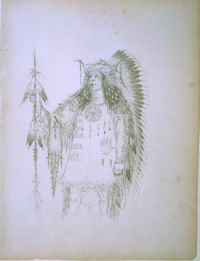Control of the Fur Trade
Fur Trade Economy
Report on the Fur Trade, 1831
Smallpox Epidemic, 1837
Children of the Fur Trade
| | |
Smallpox Epidemic, 1837
The devastation wrought by diseases that accompanied the fur trade was vividly recorded by American Fur Company trader Francis Chardon (1790?–1848) in a journal he kept while working at Fort Clark, the post adjacent to the earth lodge villages that Lewis and Clark had first visited in 1804. In the summer of 1837, Chardon witnessed a devastating smallpox epidemic as it swept through the Mandan settlements.
On July 30, Chardon recorded the dying words of Mato Tope or Four Bears (1795?–1837), a popular Mandan leader who had been a child when the American expedition wintered with his tribe thirty-three years earlier. Mato Tope recalled that he had always assisted white visitors and traders, but he now denounced them bitterly.
Click
here to read what Four Bears said.
In the 1850s, George Catlin copied a painting he had made of Four Bears in 1833 to produce this drawing. At the time, he wrote, “One of the most celebrated chiefs known to have existed amongst the North American Indian tribes … The Mandans, now extinct, numbered 2,300 when the author was amongst them….” Catlin’s tragic (and erroneous) caption reflected the growing belief among nineteenth-century observers that Native Americans could not survive the onslaught of new people and diseases. But although devastated by smallpox and other diseases, the Mandans reorganized their villages and lived on. Still, artists like Catlin were convinced that the Indians were a vanishing race.
|

| Click to Enlarge | Newberry Library |
George Catlin. "Mah to toh pa (The Four Bears)," copied
from Souvenir of the North American Indians As They Were in the Middle
of the 19th Century, 1852.
|

